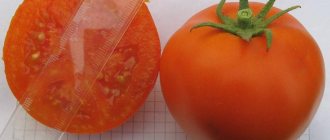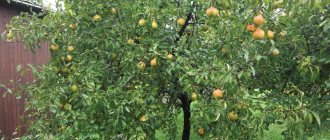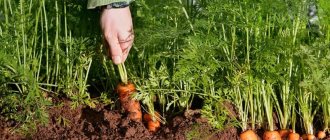Nantes carrots are considered classic; their taste has become a standard for comparing other varieties. You can get a rich and juicy harvest if you adhere to simple agrotechnical measures when cultivating the crop. More about this below.
Nantes carrot seeds
Carrot Nantes
Nantes carrots contain large amounts of carotene
Description of the variety
The Nantes carrot variety was bred by breeders in 1943 for planting throughout Russia, Ukraine and Belarus. It still enjoys well-deserved popularity. There are several varieties of this variety, which are united under the name Nantes:
| Characteristics | Nantes 4 | Nantes red | Nantes improved | Nantes Semko |
| Fruit length (cm) | 12-16 | 14-16 | 15-17 | 16-17 |
| Fruit weight (g) | 70-160 | 80-200 | 90-160 | 90-150 |
| Color | red-orange | orange | bright orange | orange |
| Ripening time (days) | 80-120 | 100-110 | 90-110 | 90-100 |
| Productivity (c/ha) | 230-260 | 260-305 | up to 600 | 280-530 |
Advantages and disadvantages
This variety of carrots has many advantages that allow it to be grown not only on personal plots, but also on an industrial scale:
- increased content of carotene, which causes the bright orange color of carrots;
- a large amount of sugar makes this variety not only desirable for children, but also allows you to obtain high-quality carrot juice from it;
- in terms of the content of phytoncides that kill pathogens, these carrots are almost as good as garlic and onions;
- has high shelf life and, if properly stored, retains its presentation until spring;
The disadvantages of this variety include its rather high demands on soil. Large yields can only be obtained on loose, fertile, not heavy soils.
Storage recommendations
Of course, this variety does not experience storage problems, and this is wonderful, but there are still certain rules used by professional gardeners that are worth listening to. Firstly, it is recommended to rinse the fruit, in several waters, and then dry it thoroughly.
Before storage, you need to cut off the tops, slightly touching the carrots. This will prevent re-sprouting in winter. Root vegetables need to be cleaned, dried, placed in plastic bags and lowered into the cellar for further storage.
Varieties of Nantes carrots
All varieties of this variety have excellent taste characteristics.
Nantes 4
Most summer residents are familiar with this variety, which is the ancestor of the Nantes carrot. This is a mid-season variety, full ripening occurs in approximately 110-120 days, but these carrots become marketable already 70 days after they sprout. This variety is one of the best for winter sowing.
Nantes improved
The variety is named so due to improvements in the uniformity and marketability of root crops. A feature of the variety is its early germination. Allows you to obtain a stable high yield, suitable for long-term storage.
Carrots are used to produce carrot juice due to their taste and high sugar content.
Nantes red
Like other varieties of Nantes carrots, it produces cylindrical orange fruits with a small tail. This variety resists well the main diseases that affect carrots. It can be stored for a long time without changing its taste.
Nantes Semko
A hybrid obtained at the end of the last century. Designed specifically for growing in large volumes, it has high yields, which can reach 810 c/ha. Suitable for mechanized cleaning. The value of the hybrid is its resistance to flowering, high shelf life and good taste.
Soil preparation
The most suitable soil for growing carrots is one that does not form a crust, such as sandy loam, loamy, and peat soils. The root crop cannot be planted under applied fresh manure. It is better if carrots are the second or third crop after manuring the soil.
The best predecessors are zucchini and early cabbage and potatoes, but carrots also grow well after tomatoes, cucumbers, onions, and mid-season cabbage.
In the fall, the area where they plan to sow carrots is dug up with the addition of humus or compost (4-6 kg/sq. m). In spring, the land is cultivated with a cultivator and harrowed with a rake. Before sowing, it is advisable to add 50 g/sq.m. to poor, non-fertile soils. m nitroammofoski. There is no need to additionally fertilize fertile soils.
Seed preparation
Carrots are a slow-germinating crop, so it is advisable to treat the seeds before sowing. There are several effective techniques for increasing the germination of carrots:
- Soaking in water. Soak the seeds for 24 hours and then dry until they flow. This will speed up the emergence of seedlings by several days.
- Hydrothermal treatment. Immerse the seeds in a gauze bag for 20 minutes in water heated to 50-52 degrees. Cool with cold water and dry. This treatment helps fight infections.
- Soaking in boric acid. Use a 0.1% boric acid solution to treat seeds during the day, this will increase yield.
- Bubbling. Pass air or oxygen through water (temperature 20 degrees) with soaked seeds. Use an aquarium aerator. Processing time 18-20 hours. Bubbled seeds sprout on 5-7 days.
Features of cultivation
Carrots are a biennial crop belonging to the celery or umbelliferous family. It can be cylindrical, conical or round in shape. The color of the root vegetable can be orange, red-orange, pink, lemon yellow and even purple.
The main requirements that carrots make when keeping them:
- Photophilous, does not tolerate placement in shady places.
- It prefers light, fertile soil - sandy loam (sandy) and loose loamy, having a slightly acidic or neutral reaction environment.
- The best predecessors of carrots are tomatoes, zucchini, cucumbers, garlic, onions, cabbage, and legumes.
- Do not plant “maiden beauty” after dill, celery and parsley.
- You should not place carrots in the same area for more than three years in a row.
- Growing method: seedless in open ground.
- Loves frequent loosening.
- Does not tolerate prolonged excessive moisture, in which case it may rot.
- With prolonged drought, root crops stop developing.
Its advantages:
- easily tolerates frosts (down to minus four degrees), long periods of cold weather;
- germinates at +3 and above, root crops grow well at +20 degrees;
- drought-resistant.
sadyrad.ru
What soil is best for Nantes carrots?
The beds are selected in the fall, taking into account the lighting of the place and the lack of nearby groundwater. In the shade, root crops grow flabby and short.
The ideal soil is sandy loam and loam; on such soil Nantes will give an excellent harvest. Root crops grow better on light, moisture-absorbing soils; these are the places you should find on your site. Acidic soils must be limed by adding dolomite flour. Heavy soils are “lightened” with peat, sand, and turf soil.
On a note! The best predecessors of this crop are tomatoes, garlic, onions, cabbage, and cucumbers. Do not sow carrots after celery, parsley, and dill.
Crop rotation must be observed, otherwise even such a productive root crop as Nantes 4 will degenerate over time. To cultivate the soil in the fall, green manure (winter rye) is sown on a carrot bed, after which the main crop is sown in the spring.
In the fall, the beds are dug up, humus (4 kg) and ash (a glass) are added. Instead of ash, you can use a complex of potassium fertilizers.
delanadache.ru
Soil and seed preparation
The best option is to start preparing the soil in the fall. When digging deeply, remove all stones that may prevent the root crop from growing. If your soil is poor, then add compost, humus, urea, and superphosphate to it. Add sawdust, peat, river sand to heavy soil, and chalk or dolomite flour to acidic soil.
It will be useful to sow the garden bed with green manure (crops that will then serve as organic fertilizers). In the spring, about a week before the intended planting, it is advisable to disinfect the bed with a warm solution of copper sulfate (measure a tablespoon of powder per ten-liter bucket).
The earth should be dug up or leveled with a rake, that is, without clods. Then cover your bed with film so that it warms up well and is moistened.
When should you sow seeds? If you want an early harvest, then from mid-April to the May holidays inclusive. For summer consumption and winter storage, choose the period from mid-May to early June. Pre-winter sowing is allowed; it is carried out from October 15 to November 10.
Seed germination is low, ranging from 55 to 75%, so it is advisable to use fresh seeds. They sprout for a long time, unfriendlyly from 14 to 20 days. This is due to the fact that the essential oils present in the seeds prevent moisture from entering them, therefore swelling and germination slow down.
To speed up the process, try to prepare the seeds for planting. There are several ways to pre-sow fragrant carrot seeds:
- Soak. We make small bags of fabric, place the seeds there and put them in warm water for a day. Try to change the water every four hours. Some people add a little wood ash to this water. After soaking, hold the bag under running warm water for some time.
- Temperature contrast. First, place the fabric bags in very hot water for 20 minutes (the temperature should be 50 degrees), and then dip them in cold water for two minutes.
- Short-term burying of seeds in the soil. To do this, fill fabric bags with dry seeds, tie them and bury them in cold soil to the depth of a spade bayonet for 10 days. Then the seeds usually germinate on the fifth day after they are sown.
- Mix the seeds with wet peat, after which they must be placed in a warm place for germination for seven days.
Choose any of the methods listed above, then dry the prepared seeds for 25 minutes in the room. Now they can be sown in the garden.
sadyrad.ru
How to sow carrots correctly
The timing is chosen based on the goals: to receive early carrots or produce for storage. In the first case, Nantes is sown in the fall (October or November, it all depends on the climate of the area) so that the seeds do not have time to germinate before the cold weather. For pre-winter sowing, the bed is prepared at the end of summer: it is dug up and fertilizers are added.
Further:
- grooves for seeds are marked on the bed;
- depth – 2-3 cm, distance between grooves – 18-20 cm;
- mix vegetable seeds with river sand, mix and sow in furrows;
- sprinkle with soil;
- covered with non-woven material.
As soon as snow falls, they cover the surface of the ridge.
When sowing in spring, the seeds are first calibrated: they are placed in a jar, filled with warm water and left for several hours. All seeds suitable for sowing will end up at the bottom of the jar, while the light (unsuitable) seeds will float to the surface. They are carefully drained along with the liquid, and the heavy seeds are dried and sown as soon as the required time comes.
Sowing time is determined by the weather, as well as soil temperature (+8ºC) and air temperature (+16ºC). The crop is considered cold-resistant, but sowing too early leads to slow germination of seedlings, and return frosts can destroy the plants.
On a note! The optimal timing is the second half of April or the beginning of May, but take into account the weather and climate of a particular area.
According to popular belief, the time to sow carrots comes when the hazel and violets bloom. According to the astrological calendar - during the waning of the Moon.
Sow in furrows (as in the winter sowing described above), be sure to then water the bed with warm, settled water. If sowed correctly, the carrots will begin to “climb out” already on the 12-15th day.
delanadache.ru
Sowing
Carrot seeds take a long time to germinate. At a soil temperature of 2-3 degrees, germination is delayed for 25-30 days. The optimal condition for seed germination is a temperature of 20-25 degrees, then the seeds will hatch in 4-5 days.
Carrot seedlings are frost-resistant and can withstand temperatures down to -4 degrees.
Based on the timing, we distinguish between winter, spring and summer sowing of carrots. The row spacing when sowing is from 25 to 45 centimeters, the distance between root crops is 5 centimeters.
Podzimny
Pre-winter sowing is usually carried out before the onset of completely freezing frosts, so that the carrots do not have time to germinate. Seed placement during this sowing is the shallowest, to a depth of no more than 1 centimeter, with loose soil sprinkled on top. This sowing allows you to get carrots 10-15 days earlier than early-ripening carrots.
Spring
Early spring sowing is used to produce early carrots for consumption and sale. Typically, sowing is carried out depending on climatic conditions in late April early May.
Carrots cannot be transplanted, because then they form a branched root. Therefore, this root crop cannot be grown with seedlings.
Summer
For autumn and winter use, carrots are sown in the first half of May and until the end of the month. If you sow carrots in June, it is quite difficult to get good shoots, but the results will be good.
The depth of seed placement ranges from 0.5 to 2.5 centimeters, depending on the properties of the soil. If groundwater passes close to the surface, then carrots are sown on ridges. In dry areas, sowing is done on a flat surface.
Landing
Before planting, you need to carefully prepare both the seeds and the beds. This culture needs good lighting; it is afraid of shadows. As for the soil, the best ones are those that allow air and water to pass through well. The best temperature for seedlings is from +9 to +15 degrees. With a sharp drop in temperature, root vegetables will lose their characteristic shade, and heat above 30 degrees has a negative effect on the formation of carrots and provokes premature aging.
Landing dates
The crop can be sown in spring or before winter. To use the vegetable for winter plantings, it is planted in May or June - it depends on the region. Pre-winter sowings are carried out when stable cold weather sets in, so that the seeds do not hatch earlier than necessary.
In spring, planting can begin immediately after the snow melts. For seedlings, a temperature of +2-4 degrees is enough. Specific dates are selected based on regional characteristics.
Landing place
A sunny place where there is no stagnant water is best. Suitable predecessors are cabbage, onions, lettuce, potatoes, cucumbers and tomatoes. The best soils are black soil, chestnut soil, peat soil, sandy soil or loamy soil. Before planting, the ground is thoroughly loosened and all debris is removed.
Landing technology
When sowing before winter, the seeds are not treated and are immersed in furrows without moisture, after which they are covered with soil. When carrying out events in spring or summer, planting material should be pre-soaked for a day and a half. After this, biological stimulants can be used.
If necessary, the seeds are mixed with sand so that they are distributed as best as possible. They are sown in carefully watered furrows to a depth of a couple of centimeters, after which they are sprinkled with soil and watered again.
Caring for carrots
Carrots do not require special care; it will be enough to weed, thin out, water and protect them from diseases and pests on time. By following some simple tips, you will get a good harvest of carrots on your plot:
- Before germination, carry out regular watering so that the soil never dries out;
- When seedlings appear, carefully water the weeds that choke the young plants;
- stop watering for 7-10 days so that the roots go as deep into the soil as possible;
- Carry out the next weeding after watering;
- during the first thinning, remove weak plants and leave stronger ones at a distance of 3-4 centimeters from each other;
- loosen the row spacing regularly, especially after watering or rain;
- during the second thinning, the strongest plants are left at intervals of 5-6 centimeters;
- when 5-6 leaves appear, apply foliar feeding with ¼ dose of mineral fertilizers;
- in July-August, water once every 7-10 days.
You should not get too carried away with nitrogen fertilizers, as their excess impairs the keeping quality of carrots. You can get more information about the rules for applying fertilizer from the article: “How, when and what to feed carrots?”.
Water carrots generously and evenly, but not so often. Watering should be regular to prevent the root crop from cracking. You can find out about the norms for watering carrots here.
Problems during cultivation and ways to solve them
When planting carrots in unsuitable soil, which is not loose enough, has a heavy structure, or clay, difficulties may arise with the emergence of seedlings.
An additional problem will be with the formation of root crops, which in such conditions grow rather short, twisted, and not very juicy. It is necessary to properly dig up the area and loosen the row spacing.
Important! “Nantes” cannot be sown in soil fertilized before plowing with fresh and insufficiently rotted manure, otherwise this will cause uncontrolled branching of the roots, that is, the appearance of “horned” carrots. It is better to apply potassium phosphate fertilizers during digging.
Despite the resistance of the variety to pest damage, there is still a need to apply preventive and therapeutic measures to prevent or eliminate such a problem. Treatment of crops with wormwood infusion diluted in 10 liters of water is considered effective.
When planting before winter or in very early spring, wet seeds should not be poured into the furrows. The planting material must be dry so that it does not germinate ahead of time and freeze.
To prevent damage to crops by a common pest, the carrot fly, onions can be planted across rows in the beds. Such a favorable proximity of crops will qualitatively protect the harvest.
na-mangale.ru
Harvest and storage
To sell carrots in bunches, they are collected as soon as the diameter of the root crop reaches 15 mm. But the greatest increase in yield occurs in September, so carrots are harvested late for storage.
Harvesting is carried out in dry weather, the tops are cut off, and the carrots are left to dry for several hours in the open air. Then the root crops are sorted, removing small, deformed and diseased ones.
The temperature for storing carrots should not exceed 2 degrees, otherwise they will begin to sprout. For longer storage, root crops are layered with sand, using boxes and filling them to a height of 70-110 centimeters. Read about other ways to store carrots in this article.
Main characteristics
This variety is perfectly adapted to different conditions: it feels good in different climates and soils. It is grown literally all over Russia, including in areas of risky farming. It is not inferior to many other hybrids, even the newest ones.
This is an early ripening variety, since it takes about 2 months from the first shoots to the receipt of root crops. But carrots reach final ripeness only after 90-120 days. So we can classify it as a mid-early variety.
The purpose of carrots is universal. It can be used fresh, for preparing soups and borscht, for canning and salads, as well as for juices or for baby food. Carrots do not have a tendency to bloom, damage by carrot fly larvae, rot and mold.
The plant is unpretentious to care. Even under unfavorable conditions it gives a good harvest. It is recommended to collect it at the end of September, although it is also possible to do this in October, but this will spoil the quality of the fruit and its keeping quality. Before harvesting for storage, it is recommended to wash and dry the fruits themselves, and cut off their tops along with the tip of the vegetable.
Pests and diseases
There are quite a few types of carrot diseases, and they get sick both during cultivation and during storage. These are mainly fungal diseases in the form of rot, in which diseased plants are destroyed and the remaining crops are treated with fungicides. Pre-sowing seed treatment is used to prevent many diseases.
| Name of the disease | Symptoms of the lesion | Treatment | Prevention |
| Fomoz | Gray-brown spots on the leaves and petioles, then the root crop is affected. | It is impossible to cure the emerging disease; the affected plants are removed. | Application of phosphorus-potassium fertilizers before planting. |
| White rot | The appearance of a white coating on the carrots, then a crust with black dots. | Increased application of potassium fertilizers, spraying with preparations containing copper. | Cleaning up weeds and waste. |
| Gray rot | Wet rot on the fruits, darkening and sogginess of the surface of the carrots. | Affected fruits are removed. | Spraying with Bordeaux mixture, feeding with nitrogen fertilizers. |
| Rhizoctoniosis | Dark gray spots inside the root crop. | Spraying plants with copper oxychloride. | Pre-sowing seed treatment. |
| Black rot | Blackening of the stem and curling of the leaves. | Treatment of plantings with fungicides containing iprodione. | Pre-sowing seed treatment. |
| Bacteriosis | Brown spots on leaves and stems, soft spots on roots, unpleasant odor. | It cannot be cured and the crops are destroyed. | Seed treatment, spraying seedlings with copper oxychloride. |
Most pests of carrots affect the above-ground part, as a result of which the root crop develops poorly, remains small and the carrot yield decreases.
| Pest | Signs of defeat | Control measures | Prevention |
| carrot fly | Red-violet leaves. | Treatment with pesticides. | Sprinkling the soil with a mixture of naphthalene and sand (1:10), removing waste. |
| carrot psyllid | Curling of leaves. | Collecting insect eggs, spraying with tobacco solution. | Loosening the soil, weeding and fertilizing plants. |
| Slugs | Eating leaves. | Adding superphosphates to the top layer of soil. | Spraying plants with infusion of garlic, hot pepper and mustard. |
| Wireworm | Point passages in the root crop. | Fertilizing with ammonia, treating with insecticides. | Maintaining sanitary cleanliness of plantings, loosening and reducing soil acidity. |
| carrot aphid | Accumulation of insects, curling and drying of leaves. | Spraying with a solution of ash and tobacco. | Weed control. |
Reviews from summer residents
★★★★★
Anna, 47 years old, housewife, Moscow region. I bought the cheapest bag of Nantes 4 carrots. I didn’t water or feed the carrots, I just loosened the soil.
Surprisingly, the carrots turned out to be quite large; several specimens cracked and split in two. But overall I'm happy with the harvest. ★★★★★
Olga, 35 years old, Nizhny Novgorod. I planted carrots of the Nantes variety.
The plants are unpretentious; I water them once a week. The rich harvest even aroused the envy of the neighbors. Next year I will plant only this. ★★★★★
Igor, 44 years old, summer resident, Tula. I had never planted carrots before, but then I came across information that carrots should be planted next to onions, as they protect each other from pests.
When the carrots grew up, I decided to try it - it tastes just wonderful. We definitely won’t have this one for long! Hide
Add your review
If you follow agricultural technology, it is absolutely not difficult to grow Nantes carrots. Currently, there are many varieties of carrots, but by choosing an old, time-tested variety, you can enjoy it at the end of July, leaving the main harvest until the fall.
0
0
Copy link
How does it grow?
Sowing is carried out from April to May. If for storage - in June. Before winter - in November.
- The site has been prepared since the fall. The site is chosen with full consecration. If planted in the shade, the roots will be of poor quality. Carrots are sown after cucumbers, zucchini, cabbage, potatoes, tomatoes and onions. You should not plant carrots after parsley or beans.
- In the treated soil per 1 sq. meter, fertilize: 1 glass of ash, 2 - 4 kg of humus, phosphorus and potassium fertilizers (Spanish instructions). It is impossible to apply unrotted manure - the carrots will begin to branch and become horned.
- The furrows are 2–3 cm deep, 30 cm between rows.
- If you sow the seeds on a ribbon, there is no need to thin out. Immediately after germination - thinning by 2–3 cm. Second, when the carrots are 1 cm thick, leave a gap of 4–5 cm.
Important ! It is necessary to weed after 2 weeks. The seedlings are watered once a week, then 2 times a month. During growth, 2 feedings with fertilizers are needed. Potassium salt (15 g), urea (10 g), superphosphates (25 g) are dissolved in 10 liters of water and applied along with irrigation.











